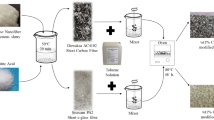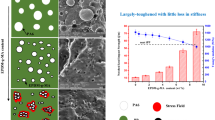Abstract
In this study, the effect of date palm tree fibres (DPTF) on the R-curve of E-glass/epoxy end-notch-flexure samples is investigated. To this aim, various DPTF types (Mesh, Rachis, Petiole, Bunch) were treated by 6 wt% of NaOH alkaline solution and then added to the resin in different weight ratios (1.5 and 5%) with sizes of 0.5–2 mm which used for four plies between the 24 plies of composite laminates. Afterwards, the fracture test was conducted according to ASTM standard. The results evidence that natural DPTFs have remarkable potential in the enhancement of the mechanical properties of the woven composite laminates. Accordingly, the addition of DPTFs causes a significant increase in the maximum bearable load as well as the initiation and steady-state fracture energy of the composite. The maximum improvement was 61% in the initiation of fracture toughness for samples with 5 wt% of Petiole fibres whilst the maximum enhancement in steady-state fracture toughness was 73% by adding 5 wt% Bunch fibres. The damage mechanisms at the delaminated interface were analyzed with macro and microscopic images. The Analyses results prove the significant DPTFs contribution in preventing the unstable crack growth which led to more energy consumption at the delaminated interface.














Similar content being viewed by others
Abbreviations
- a :
-
Crack length
- C :
-
Compliance of the specimen
- a 0 :
-
Initial crack length
- G II c i :
-
Initiation fracture energy
- b :
-
Width of the ENF specimen
- G II c prop :
-
Propagation fracture energy (delamination toughness)
- δ :
-
Load line displacement
- G II :
-
Interlaminar fracture energy
- P :
-
Applied load
- l FPZ ss :
-
Steady-state fracture process zone (FPZ) length
- ENF:
-
End Notch Flexure
- G II c :
-
Mode II fracture toughness
- l L :
-
Half of the total length of the ENF sample
- l S :
-
Span length (distance between the supports)
References
Marques J et al (2021) An overview of manufacturing functionally graded adhesives–challenges and prospects. J Adhes 97(2):172–206
Ayatollahi MR et al (2019) Effect of notch length and pre-crack size on mode II fracture energy of brittle adhesives. Eng Fract Mech 212:123–135
Zimmermann N, Wang PH (2020) A review of failure modes and fracture analysis of aircraft composite materials. Eng Fail Anal 115:104692
Liu H et al (2020) The behaviour of fibre-reinforced composites subjected to a soft impact-loading: an experimental and numerical study. Eng Fail Anal 111:104448
Lyashenko-Miller T, Marom G (2017) Delamination fracture toughness of UHMWPE fibers/polyurethane laminates interleaved with carbon nanotube-reinforced polyurethane films. Polym Adv Technol 28(5):606–612
Banks-Sills L, Simon I, Chocron T (2019) Multi-directional composite laminates: fatigue delamination propagation in mode I—a comparison. Int J Fract 219(2):175–185
Karnati SR, Shivakumar K (2020) Limited Input Benzeggagh and Kenane delamination failure criterion for mixed-mode loaded fiber reinforced composite laminates. Int J Fract 222(1):221–230
Bascom W et al (1980) The interlaminar fracture of organic-matrix, woven reinforcement composites. Composites 11(1):9–18
Funk, J.G. and J.W. Deaton (1989) The interlaminar fracture toughness of woven graphite/epoxy composites. National aeronautics and space administration Hampton va Langley research
Hirai Y, Hamada H, Kim J-K (1998) Impact response of woven glass-fabric composites—I.: effect of fibre surface treatment. Compos Sci Technol 58(1):91–104
Wood MD et al (2007) A new ENF test specimen for the mode II delamination toughness testing of stitched woven CFRP laminates. J Compos Mater 41(14):1743–1772
Delzendehrooy F et al (2021) Fracture energy assessment of adhesives Part II: is GIIc an adhesive material property? (a neural network analysis). J Adv Join Process 3:100049
Reis PN et al (2014) Interlaminar fracture in woven carbon/epoxy laminates. Frat Integr Strutt 8(30):431–438
Alif N, Carlsson LA, Gillespie JW (1997) Mode I, mode II, and mixed mode interlaminar fracture of woven fabric carbon/epoxy. In: Composite materials: testing and design, vol 13. USA: ASTM International
Gill AF, Robinson P, Pinho S (2009) Effect of variation in fibre volume fraction on modes I and II delamination behaviour of 5HS woven composites manufactured by RTM. Compos Sci Technol 69(14):2368–2375
Pereira A, De Morais A (2004) Mode II interlaminar fracture of glass/epoxy multidirectional laminates. Compos A Appl Sci Manuf 35(2):265–272
Triki E, Zouari B, Dammak F (2016) Dependence of the interlaminar fracture toughness of E-Glass/Polyester woven fabric composites laminates on ply orientation. Eng Fract Mech 159:63–78
Beckermann GW, Pickering KL (2015) Mode I and Mode II interlaminar fracture toughness of composite laminates interleaved with electrospun nanofibre veils. Compos A Appl Sci Manuf 72:11–21
Shivakumar, K.N., R. Panduranga, and M. Sharpe. Interleaved polymer matrix composites-A review. in 54th AIAA/ASME/ASCE/AHS/ASC structures, structural dynamics, and materials conference. 2013.
Brugo T, Palazzetti R (2016) The effect of thickness of Nylon 6, 6 nanofibrous mat on Modes I-II fracture mechanics of UD and woven composite laminates. Compos Struct 154:172–178
Daelemans L et al (2015) Nanofibre bridging as a toughening mechanism in carbon/epoxy composite laminates interleaved with electrospun polyamide nanofibrous veils. Compos Sci Technol 117:244–256
Yan L, Chouw N, Yuan X (2012) Improving the mechanical properties of natural fibre fabric reinforced epoxy composites by alkali treatment. J Reinf Plast Compos 31(6):425–437
Georgiopoulos P et al (2016) The effect of surface treatment on the performance of flax/biodegradable composites. Compos B Eng 106:88–98
Yang H-S et al (2004) Rice-husk flour filled polypropylene composites; mechanical and morphological study. Compos Struct 63(3):305–312
Bos HL, Müssig J, van den Oever MJA (2006) Mechanical properties of short-flax-fibre reinforced compounds. Compos A Appl Sci Manuf 37(10):1591–1604
Santulli C (2007) Impact properties of glass/plant fibre hybrid laminates. J Mater Sci 42(11):3699–3707
Mwaikambo LY, Bisanda ET (1999) The performance of cotton–kapok fabric–polyester composites. Polym Testing 18(3):181–198
Barbosa A, da Silva L, Öchsner A (2014) Effect of the amount of cork particles on the strength and glass transition temperature of a structural adhesive. Proc Inst Mech Eng Part L J Mater Des Appl 228(4):323–333
Akhavan-Safar A et al (2018) Micro failure analysis of adhesively bonded joints enhanced with natural cork particles: impact of overlap length and particles volume fraction. Frat Integr Strutt 12(46):266–274
Alawar A, Hamed AM, Al-Kaabi K (2009) Characterization of treated date palm tree fiber as composite reinforcement. Compos B Eng 40(7):601–606
Delzendehrooy F et al (2020) Strength improvement of adhesively bonded single lap joints with date palm fibers: effect of type, size, treatment method and density of fibers. Compos B Eng 188:107874
Khakpour H et al (2020) Mechanical properties of structural adhesives enhanced with natural date palm tree fibers: effects of length, density and fiber type. Compos Struct 237:111950
Mahdavi S, Kermanian H, Varshoei A (2010) Comparison of mechanical properties of date palm fiber-polyethylene composite. BioResources 5(4):2391–2403
Kaddami H et al (2006) Short palm tree fibers–thermoset matrices composites. Compos A Appl Sci Manuf 37(9):1413–1422
SatchidanandaTripathy JD, DebasmitaMishra (2016) A study on the effect of surface treatment on the physical and mechanical properties of date-palm stem fiber embedded epoxy composites. In: Proceedings 5th national conference on processing and characterization of materials (p 012036). Rourkela, India
Ghabezi P, Farahani M (2016) Composite adhesive-bonded joint reinforcement by incorporation of nano-alumina particles. J Comput Appl Mech 47(2):231–239
ASTM D7905/D7905M (2014) Standard test method for determination of the Mode II Interlaminar fracture toughness of unidirectional fiber-reinforced polymer matrix composites. https://doi.org/10.1520/D7905_D7905M-19E01
Dassios KG (2007) A review of the pull-out mechanism in the fracture of brittle-matrix fibre-reinforced composites. Adv Compos Lett 16(1):096369350701600102
Hosseini MR, Taheri-Behrooz F, Salamat-Talab M (2020) Mode II interlaminar fracture toughness of woven E-glass/epoxy composites in the presence of mat interleaves. Int J Adhes Adhes 98:102523
Salamat-Talab M, Shokrieh M, Mohaghegh M (2021) On the R-curve and cohesive law of glass/epoxy end-notch flexure specimens with 0//θ interface fiber angles. Polym Testing 93:106992
Author information
Authors and Affiliations
Corresponding author
Additional information
Technical Editor: João Marciano Laredo dos Reis.
Publisher's Note
Springer Nature remains neutral with regard to jurisdictional claims in published maps and institutional affiliations.
Rights and permissions
Springer Nature or its licensor holds exclusive rights to this article under a publishing agreement with the author(s) or other rightsholder(s); author self-archiving of the accepted manuscript version of this article is solely governed by the terms of such publishing agreement and applicable law.
About this article
Cite this article
Akhavan-Safar, A., Salamat-Talab, M., Delzendehrooy, F. et al. Effects of natural date palm tree fibres on mode II fracture energy of E-glass/epoxy plain-woven laminated composites. J Braz. Soc. Mech. Sci. Eng. 44, 457 (2022). https://doi.org/10.1007/s40430-022-03717-2
Received:
Accepted:
Published:
DOI: https://doi.org/10.1007/s40430-022-03717-2




